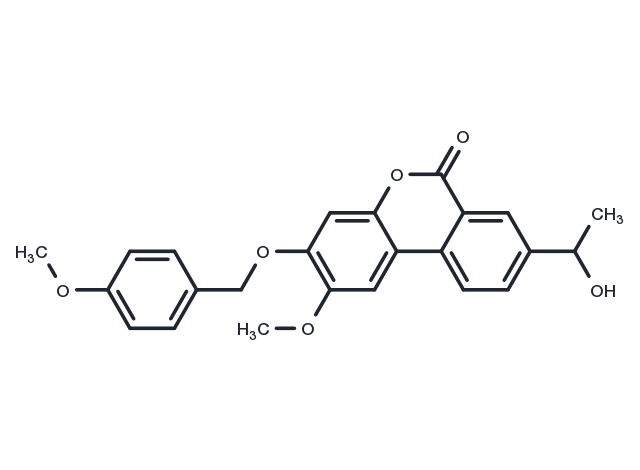Powder: -20°C for 3 years | In solvent: -80°C for 1 year


Palomid 529 (SG 00529) has been used in trials studying the treatment of Age-Related Macular Degeneration.

| Pack Size | Availability | Price/USD | Quantity |
|---|---|---|---|
| 5 mg | In stock | $ 47.00 | |
| 10 mg | In stock | $ 68.00 | |
| 25 mg | In stock | $ 133.00 | |
| 50 mg | In stock | $ 247.00 | |
| 100 mg | In stock | $ 409.00 | |
| 1 mL * 10 mM (in DMSO) | In stock | $ 52.00 |




| Description | Palomid 529 (SG 00529) has been used in trials studying the treatment of Age-Related Macular Degeneration. |
| In vitro | Palomid 529 effectively inhibits tumor growth, angiogenesis, and vascular permeability. In the rabbit retinal detachment model, it significantly suppresses the proliferation of Müller cells, the formation of neuroglial scars, and photoreceptor cell death. Additionally, Palomid 529 dose-dependently inhibits Ad-VEGF-A-driven angiogenesis and, when administered orally to nude mice, restrains the growth of C6V10 gliomas. Compared to the control group, treatment with Palomid 529 in PC-3 tumor-bearing mice results in a 57.1% reduction in tumor growth. It also markedly suppresses tumor growth in mouse models of Brca1 deficiency by inhibiting the Akt and mTOR signaling pathways. |
| In vivo | Palomid 529 not only reduces the proliferation of ischemic retina but also improves the tissue and structure of vasculogenesis. It inhibits endothelial cell proliferation mediated by VEGF and bFGF, with IC50 values of 20 nM and 30 nM, respectively. Additionally, Palomid 529 induces apoptosis in endothelial cells and reduces the phosphorylation of pAktS473, pGSK3βS9, and pS6 induced by the vascular endothelial growth factor VEGF-A. In the lung cancer NCI-60 cell line, Palomid 529 exhibits potent antiproliferative activity, with a GI50< 35 μM. Furthermore, it significantly enhances the antiproliferative effect of radiation on prostate cancer cells (PC-3), demonstrating concentration-dependent growth inhibition in PC-3 cells. Palomid 529 inhibits radiation-induced p-Akt activation and reduces the Bcl-2/Bax ratio in PC-3 cells. |
| Kinase Assay | Estrogen receptor binding assays: The proteins are produced with rabbit reticulocyte lysates. The amount of template used in each reaction is determined empirically and expression is monitored in parallel reactions where [35S]methionine is incorporated into the receptor followed by gel electrophoresis and exposure to film. Binding reactions of the estrogen receptors (ER) and Palomid 529 are carried out in 100 mL final volumes in TEG buffer [10 mM Tris (pH 7.5), 1.5 mM EDTA, 10% glycerol]. In vitro transcribed-translated receptor (5 μL) is used in each binding reaction in the presence of 0.5 nM [3H]estradiol (E2). Palomid 529 is routinely tested from 10?11 to 10?6 M and diluted in ethanol. The reactions are incubated at 4 °C overnight and bound E2 is quantified by adding 200 mL dextran-coated charcoal. After a 15-minutes rotation at 4 °C, the tubes are centrifuged for 10 minutes and 150 mL of the supernatant are added to 5 mL scintillation mixture for determination of cpm by liquid scintillation counting. The maximum binding is determined by competing bound E2 with only the ethanol vehicle. Controls for background are included in each experiment using 5 mL unprogrammed rabbit reticulocyte lysate. This value, typically 10% to 15% of the maximal counts, is subtracted from all values. The data are plotted and Ki values are calculated. Experiments are conducted at least thrice in duplicate. |
| Cell Research | Human umbilical vascular endothelial cells (HUVEC) are used. The proliferation assay is carried out by seeding the HUVECs in 96-well plates at a density of 1,000 per well in complete medium. Following a 24-hour plating period, the cells are starved for 24 hours in 0.5% serum before being treated with Palomid 529 in the presence of 10 ng/mL basic fibroblast growth factor (bFGF) or VEGF in complete medium. After 48 hours, cell number is determined using a colorimetric method. The results are expressed as the percentage of the maximal bFGF or VEGF response in the absence of Palomid 529. Nonproliferating endothelial cells are assayed by growing HUVECs to quiescence in 96-well plates and treating with Palomid 529 for 48 hours. Initially, 5,000 cells per well are seeded and confluence is achieved the next day. The plates are incubated for another 24 hours to ensure growth arrest before treatment with Palomid 529. (Only for Reference) |
| Synonyms | P529, SG 00529 |
| Molecular Weight | 406.43 |
| Formula | C24H22O6 |
| CAS No. | 914913-88-5 |
Powder: -20°C for 3 years | In solvent: -80°C for 1 year
Ethanol: < 1 mg/mL (insoluble or slightly soluble)
DMSO: 75 mg/mL (184.5 mM)
You can also refer to dose conversion for different animals. More
bottom
Please see Inhibitor Handling Instructions for more frequently ask questions. Topics include: how to prepare stock solutions, how to store products, and cautions on cell-based assays & animal experiments, etc.
Palomid 529 914913-88-5 Apoptosis PI3K/Akt/mTOR signaling mTOR P-529 P529 Palomid-529 Inhibitor Palomid529 P 529 SG00529 Mammalian target of Rapamycin SG-00529 inhibit SG 00529 inhibitor
